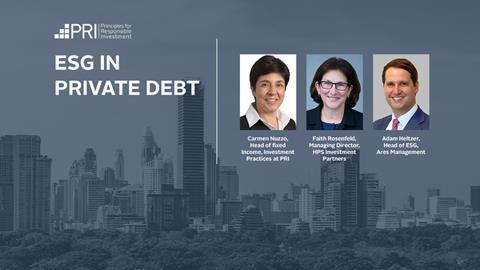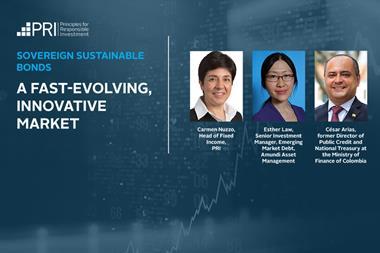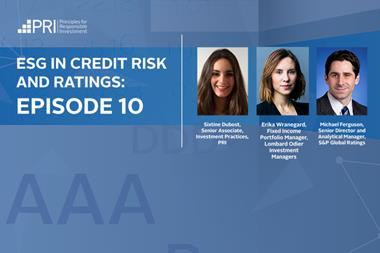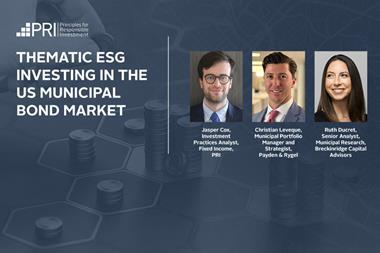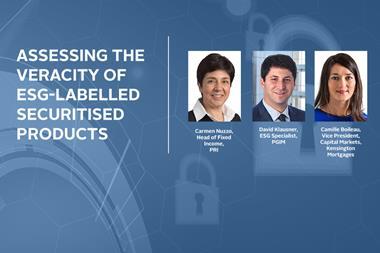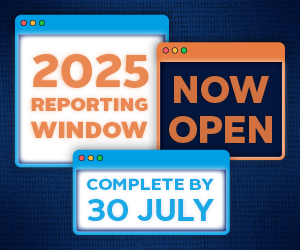With this, they discuss the ESG opportunities for private debt and private equity investors to collaborate and the regulatory implications on reporting with limited partners.
Find transcript here
Carmen Nuzzo
Welcome to today’s podcast by the PRI, the first one on environmental, social and governance, ESG consideration in private debt, an alternative form of lending compared to traditional bank loans. My name is Carmen and I’m the head of fixed income at the PRI. To discuss today why and how ESG consideration is becoming more prominent for the asset class. I’m joined by Faith Rosenfeld, managing director at HPS Investment Partners and Adam Heltzer, head of ESG at Ares Management. Faith and Adam both work for US based private credit asset managers operating globally and are part of the newly formed PRI’s advisory committee on private debt P.dot for short, which Adam also chairs. Welcome to you both
Faith Rosenfeld
Carmen, thanks for having us.
Adam Heltzer
Thanks, Carmen. Great to be here.
Carmen Nuzzo
So private debt is actually not a single asset class, but it encompasses a variety of strategies that probably deserve a separate podcast. It essentially amounts to investors buying credit instruments issued by a borrower on the private market instead of getting funds from a bank. As an asset class, private debt started gaining momentum since the global financial crisis of 2007, 2008, but the PRI has been focusing on it only in recent years in response to its growing volume, but also to rising demand by our signatories for whom ESG consideration is becoming a far more common feature in their investment analysis. Adam, my first question is for you, why in your view has private debt become so attractive in the last few years?
Adam Heltzer
You know, Carmen, I think it’s pretty simple. Private credit just solves a lot of problems for a lot of people. From a borrower’s perspective, after the global financial crisis, big banks were retrenching. They had to rein in their risk and they believed that smaller and medium sized businesses were the right place to pair back. This created this vacuum into which non-bank financial institutions began to come in. And in the years since, even after markets have stabilized, a lot of these borrowers came to prefer private credit for a few key reasons. Number one, the speed. A typical process for a syndicated loan at a bank takes about two months to execute, and a private loan can be about half that time. Number two, certainty of execution. Syndicated loans by definition involve often dozens of lenders. By contrast. For private credit, there’s usually one to maximum four, five, or six. And the last part is just customizable solutions. These companies need creative solutions that are tailored to their business, and I think that private lenders position themselves as being better partners that sort of work. Now from an asset owner perspective, compared to other fixed income assets, private debt can offer higher yields, higher allocations, and also more consistent risk adjusted returns.
Carmen Nuzzo
Definitely versatile form of credit. Can you give us a sense of the market size.
Adam Heltzer
Today? It’s about $1.5 trillion globally, which is really incredible. It’s about a 10 x increase over the last decade and that puts it roughly on par with the market for venture capital, private real estate. It’s really an asset class in its own right. Looking ahead, we see future growth. We’ve seen projections that the market’s going to double in the next six to seven years.
Carmen Nuzzo
And let’s come two ESG now, Faith, why do you think credit investors are increasingly incorporating ESG consideration into their analysis?
Faith Rosenfeld
You know, it’s interesting. I think that when it comes to ESG considerations, private debt investors are really incorporating them for several reasons. The first is to mitigate downside risks. That is to identify and assess material factors that may reduce the probability of seeing the money that they lend repaid on time and in full. You know, this isn’t completely new. Governance, for example, has always been in focus. However, today these things are being evaluated in a much more systematic fashion. For some investors, there’s also a second reason they may seek to allocate capital to drive real world outcomes by structuring mandates towards specific environmental or societal objectives or to help them reduce negative ones.
Carmen Nuzzo
It’s actually the same motivations that I hear from other asset classes, perhaps because private debt is a younger asset class, this is started later than for other financial instruments. But governance, everybody says for all fixed income instruments, there has always been part of fundamental analysis, but the focus actually on the S is increasing now. Perhaps because the materiality is also becoming more evident. So, when it comes to how ESG consideration has evolved, have you seen any change over time?
Faith Rosenfeld
Remarkable change. You know, we’ve moved on from simply screening out companies and now have moved on to having real conversations with target companies. It’s also important to distinguish between the role played by limited partners and general partners. Investors or limited partners have reporting obligations, and they are relying on the general partners to provide that information. Both have an opportunity to change the focus and increase dialogues and interactions with portfolio companies. You know, a large portion of our investor base are insurance companies, particularly large European ones, and I can assure you that ESG considerations for them are not a fad.
Adam Heltzer
Yeah, I just wanted to build on Faith for a second, which by the way is very fun to say to build on Faith, you know, this real conversations with target companies comment, it translates in public equities, par lands to engagement, which is a pretty incredible change in attitudes over the last several years. There was a time when limited partners, when evaluating private debt managers would compare it to private equity and say, hey listen, our expectations aren’t so high. We understand you don’t have control. The conversation today is much different today. It’s what can you do? How can you engage with the company? And from their perspective, they may have exposure to the same underlying portfolio company, both through private equity and through private credit managers. And so, they’re looking at it and saying, well, shouldn’t these two different groups collaborate more? Cause you know, jointly their engagement with the company to drive ESG performance improvements.
Carmen Nuzzo
Faith mentioned earlier that a lot of our clients are European insurance funds, and here in Europe where I’m based in London, we’ve seen lots of regulatory changes both at the EU level and in the UK. So, Faith, how has the regulation affected the way you have to report or the data that you have to provide and new conversations with limited partners as well?
Faith Rosenfeld
Well, Carmen, you know, ESG strategies have moved from a nice to have to a must have, and that’s partly due to regulatory changes in investor demand of ESG regulated entities. These were first spearheaded by European regulators, but truly they have much broader repercussions globally, including in the United States. Expectations shouldn’t be lower in the United States, but the challenges are greater.
Carmen Nuzzo
I’m glad that you say that because although it’s true that regulatory changes have been spearheaded in Europe, the market is a lot bigger in the US in terms of size, and so it’s going to be interesting to follow developments there, even if they’ve started later than in Europe, turning out to the PRI and its work, which is not completely new. Adam, as chair of the PDAC, what role do you see the PRI playing in promoting ESG incorporation practices in private debt?
Adam Heltzer
I think this is exactly where the PRI shines. It’s global, it’s multi-asset class. It reflects the full ecosystem of the investment industry, and it’s an agenda setter. This is where signatories find so much value, when there’s so much noise, so much content. How can the PRI provide the blueprint for how to do this work? Well, the PRI made a great start on this in 2019 by publishing a spotlight on private debt, but so much has happened in these last few years that we really have to hit the giant refresh button on that sort of document. For example, over these last few years, ESG data has become so important that there’s all these competing frameworks for the kinds of data you should disclose, the format you should disclose it in. The PRI has stepped in along with other trade associations to harmonize that, and the clear product of that has been the ESG factor map published this past June, which takes all the different frameworks and consolidates them into a single questionnaire that a target company can fill out and satisfy its many financial partners.
Carmen Nuzzo
I’m glad that you mentioned ESG factor map, Adam, because it actually was born out of the idea of two signatories and developed thanks to the help of a working group. During that time, it became apparent that we needed to drive the industry forward through the constitution of the PDAC. Faith. You are a member of the PDAC too. I know it’s newly born, it’s still in its infancy, but what would you say are the most pressing areas of work for this group beyond encouraging more collaboration with private equity investors?
Faith Rosenfeld
Well, Carmen, I’d say the first is data that is, you know, encouraging better data collection and dissemination by portfolio companies through a common framework. And we’ve touched on that earlier. Oftentimes these issuers are small companies with limited resources and in some cases they have limited awareness of why investor expectations around ESG disclosures are changing. You know, standardization and data collection and reporting has the potential to benefit the sponsor and the credit investors alike. Agreeing to common terms while retaining additional proprietary aspects of financial materiality might prove to be a successful strategy. In particular, given the focus of many limited partners on climate, a focus on the collection and dissemination of carpet information in a standardized way will be important. It’s really great to see the PRI is already working on creating an ESG credit focus questionnaire to facilitate this with the LSTA and the ACC. The second piece of the data question is that private debt investors also need to collaborate and work together to agree upon and implement uniform reporting expectations. We need to work together not just with private equity, but among ourselves to make sure that we’re not duplicating efforts. It doesn’t make sense for four different credit investors to ask the same questions in four different ways. It’s not efficient for the portfolio company and it’s not efficient for any of us.
Carmen Nuzzo
Yeah, and in fact, the ESG factor that aims precisely at that, at highlighting how many times the same question is asked by different reporting frameworks with a different wording, but the content that the information that is needed is always the same. For those of you who are not familiar with what the PRI has announced recently, we are collaborating with the LSTA, the Loan Syndications and Trading Association and the Alternative Credit Counts or the ACC precisely to carve out from that ESG factor map and more credit focused questionnaire to try and avoid duplicating efforts and become more efficient. Part of the fixed income program that I lead on, we’re seeing the proliferation now of instruments that come to the market with an ESG label or a sustainability label in the private debt market. We’re seeing sustainability link loads. What about those?
Adam Heltzer
It’s a super exciting part of the market, Carmen, because as Faith outlined before, just a few years ago, ESG and private credit meant a negative screen or nothing. And today we’re seeing what my colleagues called new technology about how to build loans that are more closely tied to ESG performance. So, what’s an ESG link loan or a sustainability link loan? In short, you tie barring costs to sustainability performance, a small discount if you hit the targets and a small penalty if you don’t, and this really builds on what Faith just mentioned, data and reporting, because I think we don’t want ESG and private credit to be just about sharing and storing information. It should be about translating that information into engagement, to reducing risk and so on. And for some investors driving sustainability outcomes, I think the big question for these ESG link loans is how can we grow this practice with substance and impact? Because they’re generally private, it’s hard to see what the actual targets are. I think the thing that we’re watching going forward is how to scale this practice with integrity and substance. A lot of the conditions in terms of these loans are not public. And so, there are conversations in the market about are they substantive enough? Are they impactful enough? Are they closely tied enough to the actual risk of the credit?
Carmen Nuzzo
These are definitely suggestions that a PRI will take on board. You said earlier you mentioned best practice. At the moment, there are no standards. Nobody knows what is the right way, but together we’re learning and by highlighting best practice, we can bring the industry forward. Grateful that Faith mentioned, the collaboration with the LSDA, the Loans, Syndications and Trading Association, and the ACC, the Alternative Credit Council. We really need to create more industry alignment, create synergies, and improve dissemination and information sharing. This new ESG credit focus will come out shortly, and I hope that many of you will help us raise the awareness in the market of this new tool that hopefully will be useful in creating not necessarily standards, but at least setting a minimum common denominator what investors should be expecting from companies. Thank you, Faith and Adam, for sharing your experience and thoughts with us today. To stay up to date on our future work, please visit www.unpri.org/private-debt. Or if you’re completely new to ESG Corporation in Fixed Income and want to start from the basics, visit www.unpri.org/fi. Thanks for listening and don’t forget to tune in for our next podcast. Until then, goodbye.
Downloads
ESG in private debt transcript
PDF, Size 0.2 mb


